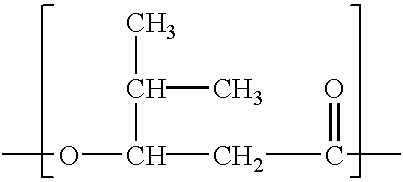Plastic articles comprising biodegradable PHA copolymers
a polyhydroxyalkanoate, biodegradable technology, applied in the direction of other domestic articles, synthetic resin layered products, bandages, etc., can solve the problems of limiting the number of possible recycling applications, affecting the quality of materials, etc., to achieve protection, promote or control plant growth, and high length-to-width ratio
- Summary
- Abstract
- Description
- Claims
- Application Information
AI Technical Summary
Benefits of technology
Problems solved by technology
Method used
Image
Examples
example 2
Poly(3-hydroxyvalerate-co-3-hydroxy-4-methylvalerate)
Poly(3-hydroxyvalerate-co-3-hydroxy-4-methylvalerate) is prepared by following the same procedure as in Example 1, with the exception that [S]-3-ethylpropiolactone (9.50 g, 94.9 mmol) and [S]-3-isopropylpropiolactone (0.71 g, 5.0 mmol) are used as the monomer charge.
example 3
Poly(3-hydroxybutyrate-co-3-hydroxyvalerate-co-3-hydroxy-4-methylvalerate)
Poly(3-hydroxybutyrate-co-3-hydroxyvalerate-co-3-hydroxy-4-methylvalerate) is prepared by following the same procedure as in Example 1, with the exception that [S]-3-methylpropiolactone (7.20 g, 83.6 mmol), [S]-3-ethylpropiolactone (1.14 .g, 11.4 mmol), and [S]-3-isopropylpropiolactone (0.71 g, 5.0 mmol) are used as the monomer charge.
example 4
Poly(3-hydroxybutyrate-co-3-hydroxy-4-methylvalerate-co-3-hydroxyoctanoate)
Poly(3-hydroxybutyrate-co-3-hydroxy-4-methylvalerate-co-3-hydroxyoctanoate) is prepared by following the same procedure as in Example 1, with the exception that [S]-3-methylpropiolactone (9.50 g, 110 mmol), [S]-3-isopropylpropiolactone (0.41 g, 2.9 mmol), and [S]-3-pentylpropiolactone (0.50 g, 2.9 mmol) are used as the monomer charge.
PUM
| Property | Measurement | Unit |
|---|---|---|
| temperatures | aaaaa | aaaaa |
| Tm | aaaaa | aaaaa |
| Tm | aaaaa | aaaaa |
Abstract
Description
Claims
Application Information
 Login to View More
Login to View More - R&D
- Intellectual Property
- Life Sciences
- Materials
- Tech Scout
- Unparalleled Data Quality
- Higher Quality Content
- 60% Fewer Hallucinations
Browse by: Latest US Patents, China's latest patents, Technical Efficacy Thesaurus, Application Domain, Technology Topic, Popular Technical Reports.
© 2025 PatSnap. All rights reserved.Legal|Privacy policy|Modern Slavery Act Transparency Statement|Sitemap|About US| Contact US: help@patsnap.com



